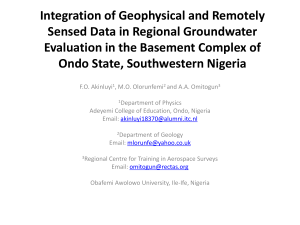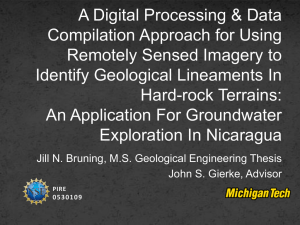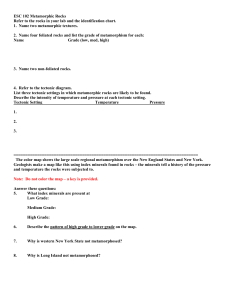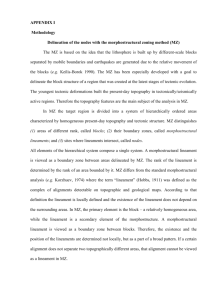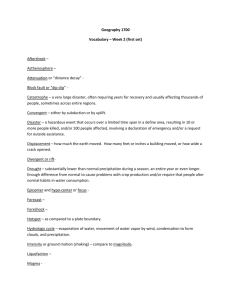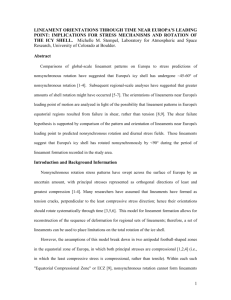Application of TM data to ... of the eastern Liaoning Province, China
advertisement
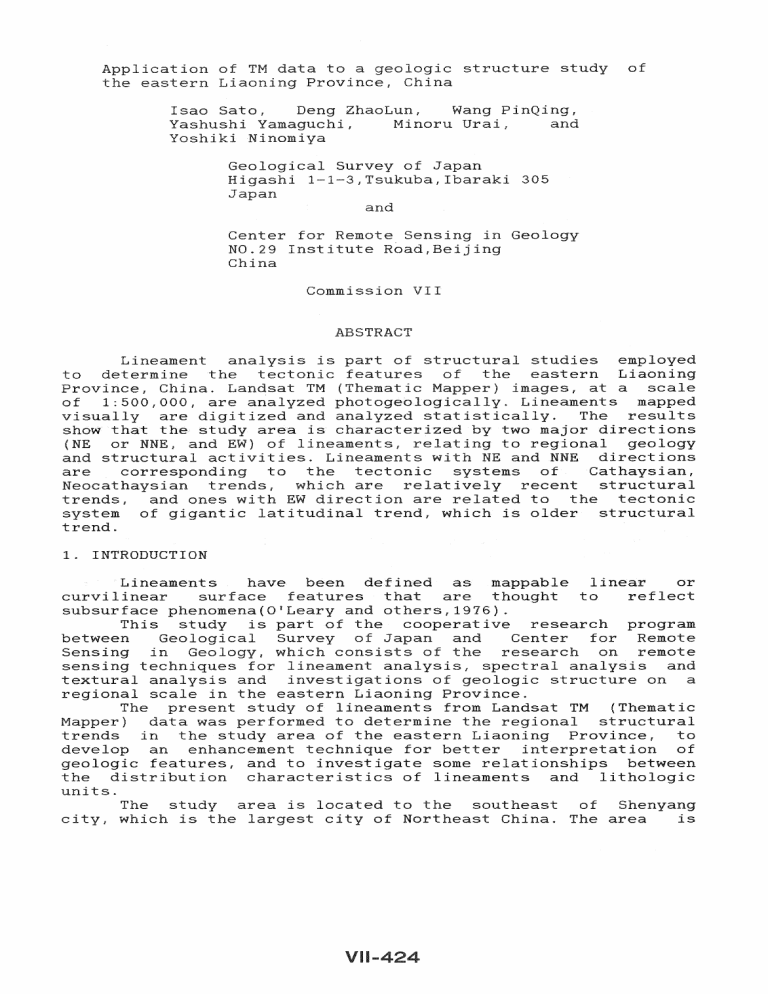
Application of TM data to a geologic structure study the eastern Liaoning Province, China of Isao Sato Deng ZhaoLun, Wang PinQing, Yashushi Yamaguchi, Minoru Urai, and Yoshiki Ninomiya 1 cal Survey of Japan 1-1-3,Tsukuba Ibaraki 305 1 and Center for Remote Sensing in Geology NO.29 Institute RoadtBeijing China Commission VII ABSTRACT Lineament is is of structural studies employed to determine the tectonic features of the eastern Liaoning Province, China. Landsat TM (Thematic Mapper) images, at a scale of 1:500 000, are analyzed photogeologically. Lineaments mapped visually are digitized and analyzed statistically. The results show that the study area is characterized by two major directions (NE or NNE, and EW) of lineaments; relating to regional geology and structural activities. Lineaments with NE and NNE directions are corresponding to the tectonic systems of Cathaysian, Neocathaysian trends, which are relatively recent structural trends t and ones with EW direction are related to the tectonic system of gigantic latitudinal trend, which is older structural trend. 1 1. INTRODUCTION Lineaments have been defined as mappable linear or curvilinear surface features that are thought to reflect subsurface phenomena(O' and others,1976). This study is part of the cooperative research program between Geological of and Center for Remote Sensing in Geology, which consists of the research on remote sensing techniques for lineament analysis, spectral analysis and textural analysis and investigations of geologic structure on a regional scale in the eastern Liaoning Province. The present study of lineaments from Landsat TM (Thematic Mapper) data was performed to determine the regional structural trends in the study area of the eastern Liaoning Province, to develop an enhancement technique for better interpretation of geologic features, and to investigate some relationships between the distribution characteristics of lineaments and lithologic units. The study area is located to the southeast of Shenyang city, which is the largest city of Northeast China. The area is o between Long.12 and 12 40 T E and between Lat.40 and 41° 20· excluding the southeast sub-area. Figure 1 shows the study area in Liaoning Province. Liaoyang/ Benxi, and Xiuyan are located in the area. The study area is about 16 600 square kilometers. Four TM full scene images are necessary to cover the area. The used TM images are cloud-free of P119-R031 t Pl19-R032, P118-R031, and Pl18-R032. These TM data were acquired by Landsat-5 satellite on 1st: and 24th November/1984 and received at Earth Observation Center of NASDA(National Space Deve Agency of Japan) which is located in Hatoyama Saitama Prefecture. A mosaic image in di tal is from the above four Landsat TM scenes(Figure 2). Visual mapping of lineaments over the areal however was carried out careful using the false color composite photoprints of individual scenes. Figure 2 shows that vegetation covers the whole area and frost remains a little in valleys in the northwest of the area where the bri ness is relatively high on the This paper describes characteristics of lineament distribution in the area of Liaoning Province and the relationsh between the distribution of older litho c units of Proterozoic and Archean and a nent lineament system with EW. An method is ed to extract linear features from TM image in detail. t I 2. GEOLOGY The eastern Liaoning area is underlain Archean, Lower Proterozoic Paleozoic and Mesozoic rocks. The geological descr ion below is based on the c System Map of the PeopleTs Republic of China and acent Sea Area on the scale of 1:2,500,000. Figure 3 is c sketch map which is ized and simplified. Archean, Sinian and Paleozoic rocks are chiefly distributing in the northern area. Lower Proterozoic rocks are widespread in the central and southern area. These areas are characterized by anticlinorium and synclinorium with approximately east-west trending folds. Jurassic rocks are scattered in the eastern area. The magmatic rocks are distributing mainly in the lower half of the area. Kuan Dian Basin is located at the lower corner of eastern area. The basin is formed by Cenozoic basic rocks. Tancheng-Lujiang fault zone with NNE trend run through to the west of the area. iang fault zone is to the east. 3. EDGE ENHANCEMENT Various methods have been wide used for enhancement of linear features on . M.Urai et al.(1985) developed an edge-enhancement method based on template matching operator. The method utilizes twelve masks which enhance directional edges every 15 . The size of mask operator is 12 by 12. The edge-enhanced images are disp using HSI(Hue, Saturation and Intensity) color model which is the alternative of RGB color model. The method s ly enhances differences of gray levels on image. The enhanced edges with different directions are assigned to different colors(Hue) and the intensity of is displayed by color intensi (Intensi ). Saturation has constant value. The resultant color shows us clearly some dominant trends of linear by different colors. However, enhanced linear includes ones ng to ridges, which are less ant for lineament mapping. Our experience shows that lineaments may be usually delineated at val With consideration of itT the ori proposed method is modified. Edges corresponding to can be eliminated using a classification of intensity tern considered with the direction of sun Ilumination(Figure 4(a) (b)). The color image become more s Ie because of ri elimination, therefore! can easi delineate linear features using it. Figure 4(c) and (d) show fied color image and an advanced which excludes as shown in figure 4 (c) . corresponding check to easi map The latter is more useful ons in detail comparing to figure linear features in f i 4 (c) . 4. STATISTICAL ANALYSIS OF LINEAMENTS Geo c features including lineaments and circular structures are visual extracted using four false color composite TM with a scale of 1:500,000. In the process of mapping, lineaments are classified into two clear and unclear ones. circular features in the area. A typical circle structure is kilometers northeast of town. Mapped lineaments are di tized for statistical analysis, which provides more detail characteristics of geo c structure. Figure 5 shows the tized lineament map, inc two classes of lineaments; solid lines clear lineaments, and dotted lines uncertain ones. Figure 6 is the density contour map of lineaments in the area. The area is divided into 60 by 60 cells. The densi of lineaments is calculated in each cell and then smoothed by a 5 ial filter. Densely-contoured region indicates high densi area of lineaments. There are two high densi areas in southern and central s. However, it should be noted that these two areas have different ies in the or trend as shown in Figure 5. The southern one is characterized lineaments with NE and NNE trends, however, the central one with NWW and EW trends. The area is divided into 5 6 sub-areas and rose diagrams of lineaments are calculated in each sub-area for investi ion of directional . Figure 7 shows their distribution map of the normalized rose diagrams with one degree step in The normalization is performed a maximum value of rose diagram in the whole area. In Figure 6 and 71 two classes of lineaments are not distinguished. It is clear that lineaments with NNE or NE trend are dominant in the southeastern area and ones with EW or ENE trend are distributed in the northwestern area. The northernmost two sub-regions include lineaments with ENE trend. For more detail is, a directional density contour map seems to be useful as shown Figure 8. These maps are made each directional range with 15 Such directional densi contour map s us directional local ies of lineaments. Detail is of structural trend show that central hi i on is clearly divided into two S; center of that on has NWW t structure and both sides of the region have EW trending structures. It also show the southern hi i on is composite of NE and NNE trending lineaments. The central highdensity region ed to NEE direction. This on is in the distributing area of Lower Proterozoic rocks. Linear features located in northwest on have also same NEE trend and form a clear zone where Archean rocks appear. These are the northernmost elements of the latitudinal structure zone. Lineaments with NW trend are also zed in this area. 5.CONCLUSIONS Lineaments are reflect to onal structures and geo c units. Zuomin(198 shows that the tectonic ems in Liaoning Province may be classif ed into latitudinal, meridional ( Cat an trend, NW trend and rotational shear tectonic ems and that the latitudinal and Cat ian trend tectonic ems consist of the onal tectonic framework. The result shows that the tectonic with Cat an trend which is characterized NE and NNE trending lineaments is dominant in the southeastern and eastern s of the area where younger volcanic rocks are wi and the tectonic with latitudinal trend is over the central and northwestern part of the area where Archean and Lower Proterozoic rocks are distributed. Two major lineament ems with EW and NE or NNE trends may the onal tectonic ems in the area. 6.REFERENCES OJ ID,W.I Friedman,J.D'1 and Pohn,H.A., 1976 Lineament ( linear, lineation: some new standards for old terms: Geo cal Soci of America Bulletin, v.86 no.4, p.495-502. Urai/M. 1 Kouda,R. Sato/I., and Tsu,H., 1985, Linear detection and color ation for Landsat MSS Journal of Remote Sensi of .5 no.4, p.515 . Institute of Geomechanics, cal Sciences 1984, Tectonic ems map of the lic of China and acent sea area (1:2 500,0 c Publishing House, Beijing. Zuomin, 1985, Characteristic and evolution of tectonic in Liaoning Province Collected works for Research of ncial tectonic ems in China 1 v.l1 p.9 -103. (in Chinese) 1 j 1 l 1 l 42 40 0 0 0 124 0 125 0 r-------:rr--------r---~.."...._-___, 4 2 0 122 123 rJ Q . ~ Xl..... · u_y_a_n _ _- - f _ - - ' 123 0 Ll.aodong 400 Peninsula llow Figure 1. The sketch map of the study area Figure 2. False color composite of the area in the eastern Liaoning Province. The is a mosaic of four Landsat TM scenes. The scene identifications are: Path Row Date Landsat 118 118 119 119 031 32 0 32 84 101 8 1 1 8 8 L5 L5 L5 L5 """", """", mmm~5 Figure 3. Geo c sketch map I-Archaean, 2-Lower Proterozoic, 3-Sinian, 4-Paleozoic 5Lower Paleozoic, 6-Upper Paleozoic, 7-middle-lower series of Jurassic, a-upper series of Jurassic, 9-Archaean and Proterozoic intermediate-acidic rocks, IO-Proterozoic intermedi rocks, 11-Mesozoic intermediate-acidic rocks, 12-Proterozoic intermediate rocks, 13-Mesozoic intermediate rocks, 14-Mesozoic alkaline rocks, 15-basic rocks. y IIIIIII Sun tllumjn~tion Topogr~phy Y~l1ey ridge Y~l1 S~tellite im~ge ridge (b) (c) (d) Figure 4. Advanced edge-enhancement method. (a) conceptual edge model, (b) examples of template operators, (c) an edge-enhanced color image which includes edges corresponding to ridges and valleys, (d) an advanced edgeenhanced color image which excludes edges corresponding to ridges. 1 ,1 . . . . . . . I, / /. .,/, . . . '-". -" . :r/':'~'"./':' / .... ; I .' •• Figure 5. // ~~I Digitized lineament map. Solid lines clear lineaments and dotted unclear ones. Large lakes and rivers are drawn in map. Figure 6. Lineament densi contour map. line this O. 0 o 100.00 VALUE o 100. 00 VALUE o. 0 100.00 VALUE a 100.00 VALUE a 100. 00 VALUE 100.00 VALUE ~ 0 0.00 VALUE o 100.00 VALUE a 100. 00 VALUE o O. 0 I I 100. I 00 VALUE ~ O. "11~ ~r~ ~~ . 0 100.00 VALUE O. a 100. 00 VALUE o 100. 00 VALUE ~ 1O~.OO , I VALUE 100.00 VALUE a 100.00 VALUE Figure 7. Rose diagrams of 5 by 6 divided sub-areas. The step in angle is one degree. VII ... 433 37.5--52.5<> 52.5-67.5" 127 . 5.....,. 142. 5 <> 157 .5--" 17 2 . 5 <> L......-_------"-_ _ _ _ _ _ _ _ _ _ _ Figure 8. Directional lineament density contour maps. The range in angle measured anti-clockwise from the east is on the top of each map. I 1 VIl . . 434
